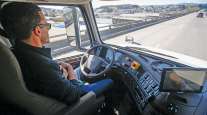Self-Driving Cars Could Save Lives Even Before They’re Perfected, Report Says

Putting self-driving cars on the road sooner rather than later could save hundreds of thousands of lives, according to a report released Nov. 6 by Rand Corp., a Santa Monica, Calif., policy research nonprofit.
The study analyzes the impact on traffic fatalities if early autonomous vehicles — those considered “moderately safe” rather than “nearly perfect” — get a green light for widespread use.
“Getting them on the road when they’re just better than average saves a lot of lives; it could be hundreds of thousands, up to half a million,” said Nidhi Kalra, who co-authored the report and is director of Rand’s San Francisco office. “We can create a lot of societal benefits by getting the technology out there sooner.”
RELATED: Bill allowing 80,000 self-driving cars on the road passes Senate panel
Although these better-than-average early self-driving cars “would still cause many crashes, injuries and fatalities,” the number would be much lower than those caused by humans, the report said.
In the U.S., more than 35,000 people died and 2.4 million were injured in vehicle crashes in 2015, according to National Safety Council data cited by the report. Worldwide, auto fatalities are more than 1.3 million a year. More than 90% of crashes are due to human error.
Robot-controlled cars — which currently exist only as test prototypes — won’t text, get drunk or distracted, or fall asleep, their advocates frequently point out.
Still, it’s hard to believe that state and federal lawmakers, who are currently thrashing out how to regulate self-driving cars, will be swayed by theoretical numbers showing that autonomous vehicles are safer. As soon as a self-driving car makes an error and kills someone, that person’s friends and relatives will lobby loudly and passionately to get the cars off the road.
RELATED: Lyft to unleash self-driving cars on San Francisco roads
Surveys have found that half of Americans don’t trust robot cars. The May 2016 fatal crash of a Tesla in Autopilot mode received intense media coverage although regulators said the driver over-relied on the technology.
“There’s a real risk if you don’t carefully prepare the public,” said Dave Groves, senior policy researcher at Rand and a study co-author.
“If the public is not ready for fatalities involving autonomous vehicles when they are first rolled out, it could cause a delay,” he said. “Maybe the whole technology would get put on ice for 20 years.”
Early deployment would help the cars get better faster, as they’d learn on the road, the report said.
“We allow new (human) drivers with a fairly low threshold of performance, with the idea that they need to be on the road to become good drivers,” Kalra said. “The new autonomous vehicles can get even better by being exposed to all sorts of weird scenarios. That phenomenon would also result in lives being saved.”
Kalra said she’s frequently asked by policymakers how safe the vehicles need to be before they should be allowed, which was the impetus for the research. But how will regulators decide that robot cars are, indeed, safer than humans?
“I have an unsatisfying answer: No one yet knows how we will demonstrate that level of safety,” Kalra said. “It’s a problem the companies themselves are struggling with.”
RELATED: Regulators move to rewrite rules for self-driving cars
Rand’s modeling doesn’t take into account what would happen if the vehicles were hacked by terrorists, potentially turning them into weapons. The autonomous cars would have to have “very strong safeguards and consideration of out-of-left-field, difficult-to-predict situations like hacking,” Groves said.
Certain aspects of self-driving technology, like automatic braking if an obstacle looms or sensors to stop drivers from straying into other lanes, are boosting safety already in human-driven cars — and such technologies are likely to continue to improve over time.
The study tried to calculate road fatalities over time under hundreds of different future scenarios and different safety requirements for robot cars’ introduction. An interactive website lets users adjust criteria and see different results themselves.
Some consumer advocates warn that the country is rushing into unproven technology that could cost lives.
“The argument that robot cars and trucks will virtually eliminate crashes is based on a fallacy: that machines are infallible,” Consumer Watchdog founder Harvey Rosenfield wrote in a June report. “So for the moment, the claim that robot vehicles will dramatically reduce vehicular deaths, injuries and property damage is simply speculation. ... In the short term, autonomous vehicles will pose new and unprecedented risks as they interact with traditional cars and trucks on the hybrid highway.”
Relying on computer algorithms, with their “bugs or biases,” to make life-or-death decisions is foolhardy, Rosenfield’s report said.
Distributed by Tribune Content Agency, LLC




